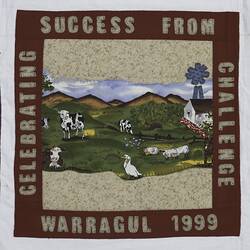Summary
History board created for the heritage display at the North East (Beechworth) Gathering in 2001, illustrating the highlights the 1992 Numurkah Women on Farms Gathering. This display was prepared by North East (Beechworth) committee member Rhonda Diffey, and also featured the icons and history boards from all the gatherings up to 2001. From this emerged a partnership with Museum Victoria (formally signed at the Yarram Gathering in 2003) to document the history of the Women on Farms Gathering. These icons and history boards were then acquired as part of the Victorian Women on Farms Gathering Collection. Following the 2001 display history boards were prepared by each organising committee, and displayed as a collection at many subsequent gatherings.
Part of Museums Victoria's Invisible Farmer Project Collection. The Invisible Farmer Project was the largest ever study of Australian women on the land, uncovering the histories and stories of Australian women in agriculture. It began as a pilot project (2015-2016) and evolved into a three year (2017-2020) nation-wide partnership between rural communities, academic, government and cultural organisations, funded by the Australian Research Council.the absence of rural women in mainstream histories and museums.
Physical Description
White foamcore board with Green title. There are pictures and text printed on white paper attached.
Significance
Since the first Victorian Women on Farms Gathering in 1990, a strong sense of historical consciousness has been fostered among Gathering participants. This has been facilitated through the sharing of stories, exchanging of objects and carrying out of regular rituals and traditions, all of which have acknowledged the important and varied contributions that rural women have made, and continue to make, to rural Australian life. At the 2001 North East (Beechworth) Gathering, this historical consciousness was taken to a new level; not only did the Gathering include the customary traditions of storytelling, but the local organising committee decided to make history and heritage a main focus of their Gathering. As well as offering heritage workshops and tours, a heritage display was made available for viewing in the main theatre of the convention centre. Included in this display was an exhibition of quilts by North East quilters and craftswomen, a 'Pioneer Woman Display' (loaned from the Royal Historical Society of Victoria) and a series of 'Women on Farms Gathering History Boards' that were created by committee member Rhonda Diffey. The history boards highlighted the history of each past Gathering and generated considerable interest from Gathering participants, who were concerned that the history of the Victorian Women on Farms Gathering community be appropriately documented and recorded.
According to the 2001 North East (Beechworth) proceedings, the creation of the history boards was intended to 'encourage the acquisition of further information and photographs, and to provide an example of what may become a permanent collection.' Members of the North East (Beechworth) organising committee were keenly aware of the importance of the Victorian Women on Farms Gatherings to the wider history of the Australian rural women's movement, and also to Australian history more generally. 'Our Gathering feels that we would like to preserve and conserve these tokens/objects for posterity', stated the North East (Beechworth) Gathering proceedings, 'as they are of high significance.' To this end, a unanimous decision was made at the Gathering to approach Museum Victoria about preserving the history of the Gatherings. A Heritage Group was formed among Gathering participants and in 2003 a formal partnership was signed between Museum Victoria and the Victorian Women on Farms Gathering community. This agreement - titled the Agreement Between Museums Board of Victoria and Victorian Women on Farms Gathering - laid out a vision to 'protect, preserve, document, exhibit and enhance access and understanding of the stories relating to Victorian Women on Farms Gatherings.'
The history boards are an important symbol of the Australian rural women's movement - a movement that sought to raise the profile, opportunities and voice of rural women. In approaching Museum Victoria about preserving their collective past, the Women on Farms Gathering community not only sought to raise their profile in the present, but also to redress the historical invisibility of farming women in contemporary Australian society, and indeed, in the historical record.
More Information
-
Collection Names
-
Collecting Areas
Sustainable Futures, Home & Community, Working Life & Trades
-
Acquisition Information
Donation from Victorian Women on Farms Gathering, Merlyn Rendell - Yarram Women on Farms Gathering, 28 Mar 2004
-
Place & Date Depicted
-
Commissioned By
Victorian Women on Farms Gathering, Victoria, Australia, 2001
-
Creator
Ms Rhonda Diffey - Member, Organising Committee, North East Women on Farms Gathering, Beechworth, North East, Victoria, Australia, 2001
-
Inscriptions
Women on Farms/Gathering/3rd Numurkah 1992
-
Classification
Agriculture & rural life, Community activity - women on farms gathering, Exhibition heritage
-
Category
-
Discipline
-
Type of item
-
Dimensions
410 mm (Width), 512 mm (Height)
-
Keywords
Agriculture, Rituals, Rural Women, Farmers, Display Boards, Conferences, Women's Movement, Community Groups, Farms, Women on Farms Gatherings, Agricultural & Farming Organisations, Rural Victoria

